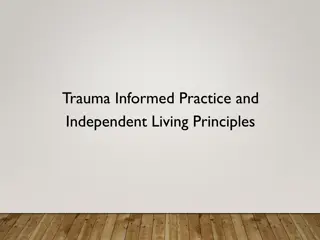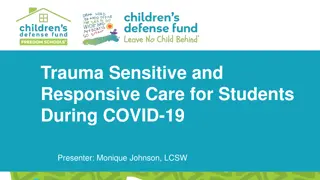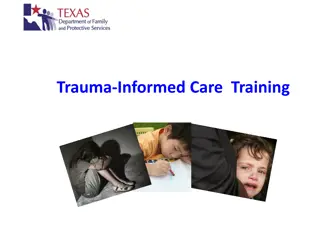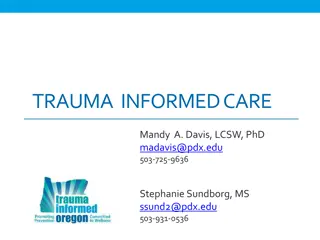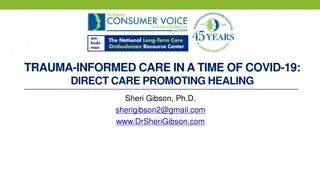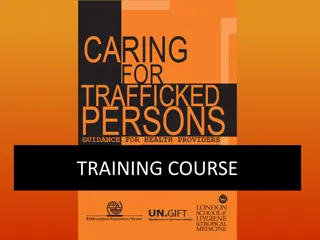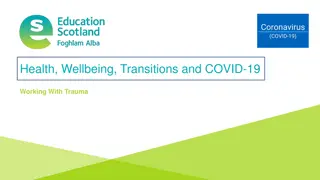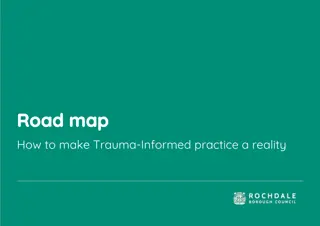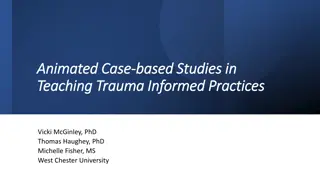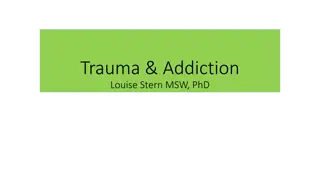Understanding Trauma-Informed Care During COVID-19
This primer by Dr. Sheri Gibson explores trauma-informed care in the context of COVID-19, emphasizing the multifaceted individual responses to trauma. It delves into the elements of trauma-informed care, the prevalence of trauma, and provides insights on recognizing and addressing trauma amidst the pandemic. The primer highlights the importance of prevention, effective treatment, and the power of empathy in supporting individuals facing traumatic events.
Download Presentation

Please find below an Image/Link to download the presentation.
The content on the website is provided AS IS for your information and personal use only. It may not be sold, licensed, or shared on other websites without obtaining consent from the author. Download presentation by click this link. If you encounter any issues during the download, it is possible that the publisher has removed the file from their server.
E N D
Presentation Transcript
TRAUMA-INFORMED CARE IN A TIME OF COVID-19: A PRIMER FOR FAMILIES Sheri Gibson, Ph.D. sherigibson2@gmail.com www.DrSheriGibson.com
Individual Responses are Multifaceted Pre-pandemic circumstances and resources Prior exposure to adversity Physical and mental health vulnerabilities Economic and social supports Exposures encountered since the pandemic: Illness of a family member Loss of job or health insurance Job status essential health care workers Time immersed in social media, news, over-exposure to information Community-level stressors e.g., Hot spots
Trauma-Informed Care SAMHSA s Trauma-Informed Approach: Behavioral Health is essential to health Prevention works Treatment is effective
Trauma Informed Care Elements Understanding the prevalence of trauma Recognizing how trauma impacts individuals Putting this knowledge into practice to actively resist re-traumatization SAMHSA
Prevalence of Trauma: Approach Video: Power of Empathy https://www.youtube.com/watch?v=1Evwgu369Jw
What is Trauma? Individual trauma results from an event, series of events, or set of circumstances experienced by an individual as physically or emotionally harmful or life threatening and that has lasting adverse effects on the individual s functioning and mental, physical, social, emotional, or spiritual well-being
Potential Traumatic Events Chronic Stressors Poverty Racism Invasive medical procedure Community trauma Historical trauma Family member with substance use disorder Abuse Emotional Sexual Physical Domestic violence Witnessing violence Bullying Cyberbullying Institutional Loss Death Abandonment Neglect Separation Natural disaster Accidents Terrorism War
Prevalence of Trauma Exposure to trauma is ubiquitous: seven out of ten respondents worldwide and nine out of ten adults in the USA report experiencing one or more lifetime traumas. Fink, Galea, 2015
Impact of Trauma on the Brain The brain has a bottom-up organization Experiences build brain architecture Fear activates the amygdala and shuts down the frontal lobes of the cortex. Toxic stress derails healthy development, and interferes with normal functioning Perry, 2006
Impact of Trauma: Adverse Childhood Experiences CDC
Impact of Trauma The effect of trauma on an individual can be conceptualized as a normal response to an abnormal situation
Impact of Trauma: Problems OR Adaptations? Non-compliant, combative OR Struggling to regain or hold onto personal power Fight Treatment resistant, uncooperative OR Disengaging, withdrawing Flight Passive, unmotivated OR Giving in to those in power Freeze
Impact of Trauma: Signs of Trauma Responses Flashbacks or frequent nightmares Sensitivity to noise or to being touched Always expecting something bad to happen Not remembering periods of one s life Feeling emotionally numb Lack of concentration Irritability Excessive watchfulness, anxiety, anger, shame or sadness Additional Signs
Six Core Principles of Trauma Informed Care
Principles of Trauma Informed Care Trustworthiness and Transparency Understanding Safety Collaboration and Mutuality Choice Empowerment SAMHSA
Principles of Trauma Informed Care: Understanding Through knowledge and understanding of trauma and stress we can act compassionately and take well-informed steps towards wellness. LTC communities actively move past cultural stereotypes and biases, offer gender-responsive services, leverage the healing value of traditional cultural connections, and recognize and address historical trauma.
Principles of Trauma Informed Care: Safety Staff and the people served feel physically and psychologically safe.
Principles of Trauma Informed Care: Safety For Clients Safety means maximizing control over their own lives For Safety means maximizing control over the service environment and minimizing risk Providers
Principles of Trauma Informed Care: Trustworthiness & Transparency Operations and decisions are conducted with transparency and the goal of building and maintaining trust among participants, family members, staff, and others, including through meaningful sharing of power, mutual decision- making, authenticity, and consistency. Roger D. Fallot and Maxine Harris, 2006
Principles of Trauma Informed Care: Choice Individuals strengths and experiences are recognized and built upon. The experience of having a voice and choice is validated and new skills developed. The organization fosters a belief in resilience. Residents are supported in developing self-advocacy skills.
Principles of Trauma Informed Care: Collaboration & Mutuality Partnership and leveling of power differences, recognizing healing happens in relationships and meaningful sharing of power in decision making.
Principles of Trauma Informed Care: Empowerment Communities recognize, build on and validate resident s strengths, individually and through peer support. Peer support and mutual self-help are key vehicles for establishing safety and hope, building trust, enhancing collaboration, serving as models of recovery and healing, and maximizing a sense of empowerment.
Principles of Trauma Informed Care: Empowerment through Peer Support Peer support is a flexible approach to building mutual, healing relationships among equals, based on core values and principles: Voluntary Non-judgmental Respectful Reciprocal Empathetic
Trauma Informed Care: Further Reading Judith Herman (2015) Trauma and Recovery Linda Sanford (1991) Strong at the Broken Places Robert Sapolsky (2004) Why Zebras Don t Get Ulcers Bessel Van Der Kolk (2014). The Body Keeps the Score
Trauma Informed Care: Bibliography Alameda County Behavioral Health Care Services. Trauma Informed Care. alamedacountytraumainformedcare.org Brown, D. W., Anda, R. F., Tiemeier, H., Felitti, V. J., Edwards, V. J., Croft, J. B., & Giles, W. H. (2009). Adverse childhood experiences and the risk of premature mortality. American Journal of Preventive Medicine, 37, 389 396. Centers for Disease Control and Prevention. About the CDC-Kaiser ACE Study. https://www.cdc.gov/violenceprevention/acestudy/about.html
Trauma Informed Care: Bibliography Felitti, Vincent J.; Anda, Robert F.; Nordenberg, Dale; Williamson, David; Spitz, Alison; Edwards, Valerie; Koss, Mary; and Marks, James. (1998) Relationship of Child Abuse and Household Dysfunction to Many of the Leading Causes of Death in Adults. American Journal of Preventive Medicine, 14:4, 245-258. Fink, David S., and Galea, Sandro. (2015). Life Course Epidemiology of Trauma and Related Psychopathology in Civilian Populations. Curr Psychiatry Rep, 17:31. Lieberman, Leslie. Walking the Walk: Modeling Trauma Informed Practice in the Training Environment. Multiplying Connections.
Trauma Informed Care: Bibliography Mueser, K.T., Salyers, M.P., Rosenberg, S.D., Goodman, L.A., Essock, S.M., et al. (2004). Interpersonal Trauma and Posttraumatic Stress Disorder in Patients With Severe Mental Illness: Demographic, Clinical, and Health Correlates. Schizophrenia Bulletin, 30 (1), 45-57 Read et al, 2008 National Center for PTSD. http://www.ptsd.va.gov/public/pages/ptsd_substance_abuse_veterans.asp Perry, B. D. (2006). Applying principles of neurodevelopment to clinical work with maltreated and traumatized children: The neurosequential model of therapeutics. In Boyd- Webb, N, ed. Working with traumatized youth in child welfare. New York: Guilford Press.
Trauma Informed Care: Bibliography Substance Abuse and Mental Health Services Administration, Center for Mental Health Services, National Center for Trauma Informed Care. SAMHSA s Trauma Informed Approach: Key Assumptions and Principles Curriculum. Substance Abuse and Mental Health Services Administration. SAMHSA s Concept of Trauma and Guidance for a Trauma Informed Approach. HHS Publication No. (SMA) 14-4884. Rockville, MD: Substance Abuse and Mental Health Services Administration, 2014. SAMHSA (2011). Current Statistics on the Prevalence and Characteristics of People Experiencing Homelessness in the United States. http://homeless.samhsa.gov/ResourceFiles/hrc_factsheet.pdf SAMHSA (2009) Substance Abuse Treatment: Addressing the Specific Needs of Women. Treatment Improvement Protocol (TIP) Series, No. 51. Center for Substance Abuse Treatment. Rockville (MD): Substance Abuse and Mental Health Services Administration.
Trauma Informed Care: Bibliography Wisconsin Department of Health Services. Trauma Informed Care Skill Development. Wisconsin Department of Health Services, Division of Mental Health and Substance Abuse Services. https://www.dhs.wisconsin.gov/tic/skilldev.pdf
Trauma-Informed, Person-Centered Care Resources NORC Trauma-informed care https://ltcombudsman.org/issues/trauma-informed-care Person-centered care - https://ltcombudsman.org/issues/person-centered-care Consumer Voice Resident-Directed Care/Culture Change https://theconsumervoice.org/issues/for- advocates/resident-directed-care My Personal Directions for Quality Living - Blank Form & Sample A tool from Consumer Voice, with edits by SAGE, for individuals to share what matters to them for person-centered care. Information for LTC consumers - https://theconsumervoice.org/issues/recipients Information for Family Members - https://theconsumervoice.org/issues/family
Resources National Long-Term Care Ombudsman Resource Center (NORC) www.ltcombudsman.org Coronavirus Prevention in Long-Term Care Facilities: Information for Ombudsman Programs https://ltcombudsman.org/omb_support/COVID-19 National Consumer Voice for Quality Long-Term Care (Consumer Voice) www.theconsumervoice.org Coronavirus in Long-Term Care Facilities: Information for Advocates https://theconsumervoice.org/issues/other-issues-and-resources/covid-19 Coronavirus in Long-Term Care Facilities: Information for Residents and Families https://theconsumervoice.org/issues/other-issues-and-resources/covid-19/residents-families
Connect with us: www.ltcombudsman.org ombudcenter@theconsumervoice.org cid:image003.jpg@01CFB310.A36779F0 The National LTC Ombudsman Resource Center cid:image004.jpg@01CFB310.A36779F0 @LTCombudcenter Get our app! Search for "LTC Ombudsman Resource Center" in the Apple Store or Google Play This project was supported, in part, by grant number 90OMRC0001-01-00, from the U.S. Administration for Community Living, Department of Health and Human Services, Washington, D.C. 20201. Grantees undertaking projects under government sponsorship are encouraged to express freely their findings and conclusions. Points of view or opinions do not, therefore, necessarily represent official Administration for Community Living policy.





